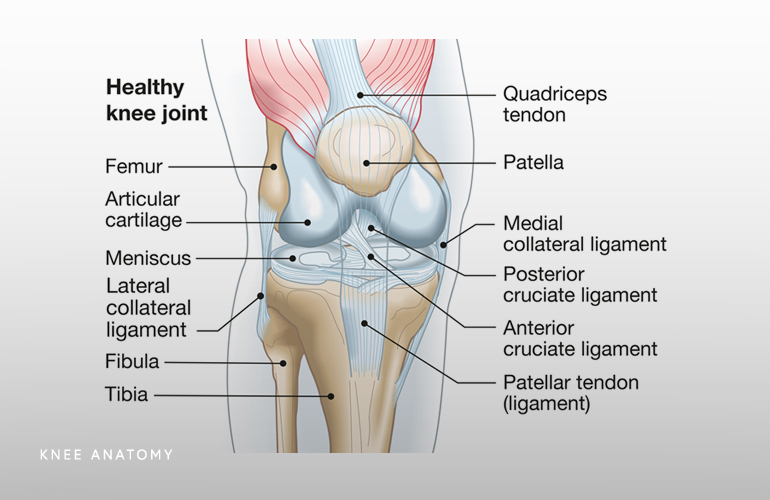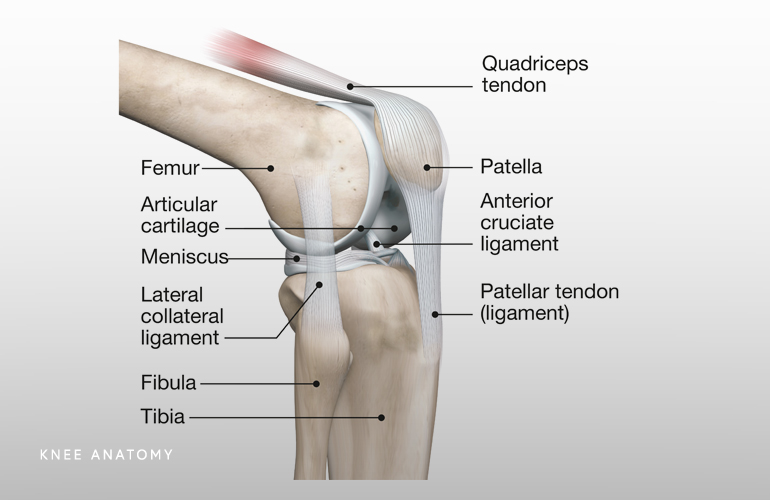Knee
Orthopaedic knee surgery in Naperville
Naperville Orthopaedic surgeon, Dr. Zahab S. Ahsan specializes in the diagnosis and treatment of knee conditions and injuries. Knee injuries can be activity limiting and affect your quality of life. Dr. Ahsan offers state-of-the-art and comprehensive sports medicine care for patients of all ages and activity levels with knee pain and injuries. Ranging common knee injuries such as ACL and meniscus tears, to complex arthroscopic reconstructive knee surgery, Dr. Ahsan can help.
An overview on knee anatomy

The human knee is complex with many structures that allows the joint to flex, extend, twist and handle daily activity loads. Any of these structures can become injured from a sports collision, overuse, or traumatic event. The knee joint is the largest in the body and is composed of four major structures – bones, cartilage, ligaments and tendons.
Three bones connect to form the knee joint:
- Femur (Thigh bone)
- Tibia (Shin bone)
- Patella (Kneecap)
The bones of the knee are lined with articular cartilage, a smooth surface that eliminates friction and allows the bones to glide smoothly with knee motion. There are two wedge-shaped pieces of cartilage known as Menisci which serve as “shock absorbers” between the femur and tibia, which help to decrease load on the articular cartilage and prevent the development of arthritis.

The bones are connected to one another by ligaments. These ligaments act like strong ropes to hold the bones together and provide knee stability. The collateral ligaments which control the sideways motion of the knee and brace it against unusual movement. The cruciate ligaments control the forward and backward motions of the knee and provide rotational control to the knee.
The knee ligaments include:
- Anterior cruciate ligament (ACL): This ligament travels from the front of the tibia to the back of the femur and prevents the tibia from moving forward and provides additional rotational stability to the knee. This is one of the most important structures in the knee and is the most commonly injured in twisting movements.
- Medial collateral ligament (MCL): This ligament is a band that runs between the inner surfaces of the tibia and femur and prevents the knee from collapsing inwards.
- Posterior cruciate ligament (PCL): This ligament travels from the back of the tibia to the front of the femur and wraps around the ACL. It is the largest and strongest ligament in the knee and is not commonly injured. It prevents the tibia from sliding backwards on the knee.
- Lateral collateral ligament (LCL): This ligament is located on the outside of the knee on the outer surface of the femur and fibula. It resists impact from the knee’s inner surface and prevents the knee from collapsing outwards.
The remaining structures of knee anatomy are the tendons and muscles. The patellar tendon stretches from the patella to the tibia. The quadriceps tendon connects the front thigh muscles to the patella. These muscles allow for to extending (straighten) your knee.
Common knee injuries
- Knee Meniscus Tears
- Patella dislocation
- Knee tendon ruptures
- Knee Cartilage Injuries
- Ligament sprains and tears
Many of the common knee injuries can be treated by a non-surgical approach. If surgery is needed, Dr. Ahsan will determine the most minimally invasive surgical technique to alleviate pain, improve knee stability and return the anatomy of the knee to its proper condition.
If you would like more information on knee anatomy and common knee injuries, contact Dr. Zahab Ahsan, orthopaedic knee specialist in Naperville, IL.
At a Glance
Dr. Zahab Ahsan
- Board Certified & Fellowship-Trained Orthopedic Surgeon
- Former Assistant Team Physician for the NY Knicks
- Castle Connolly Top Doctor
- Team Physician for Chicago Fire FC
- Learn more


